
Little Baobab, germinated from seed in the wild
Taking Care of germinated baobab seeds – an overview:
In summary, I found that baobab seeds thrive best if they are planted in early summer in a pot that is at least 10 cm deep. The latter provides them with space to develop the small taproot. If possible, do not repot the small baobabs during the first three months so as not to disturb the root development. The trees like bright, sunny and wind-protected locations. They do not like draughts and appreciate temperatures of around 24° C, need regular watering but no standing water. During summer they enjoy sunny spots on balconies, verandas or in gardens. Pot and soil should allow good water drainage, otherwise they easily catch root rot. During prolonged rainfall, “park” your baobabs in a dry location.
The small plants are susceptible to pests, for example aphids or spider mites, especially if they are kept outdoors. But leaf-eating insects also love the tasty leaves. That is why you should regularly check them for pests. Especially spider mites and aphids like to appear in dry, hot summers. You can get rid of them by showering the plants with rainwater. In severe cases, a product from a specialist shop can also help. Believe it or not: in their countries of origin, leaves and young shoots of baobabs are popular with goats, chickens, cattle and antelopes. If you keep chickens in your garden, you should protect your trees from them.
How to take proper care of germinated baobab seeds:
Baobabs are frugal plants you will enjoy for a long time if you care fort hem properly. They grow very well in pots or planters. The seeds germinate relatively easy if you take a few things into account. If they meet the right conditions, baobab seeds germinate quickly and – contrary to popular opinion – grow rapidly during their first years.

Baobabsetzlinge, Limpopo, Südafrika, Heike Pander
But what happens after germination – how do you take care of your precious little trees? Baobabs face some risks that can impair growth or even lead to their death. You can prevent complications once the seeds germinated if you pay attention to the following issues:
The small trees need stable conditions so that they can grow quickly. These include
- A bright location, if possible no glaring sunlight.
- Temperature – preferably at a constant level of around 24°C.
- Regular watering
- The right soil
- The best timing for germinating seeds
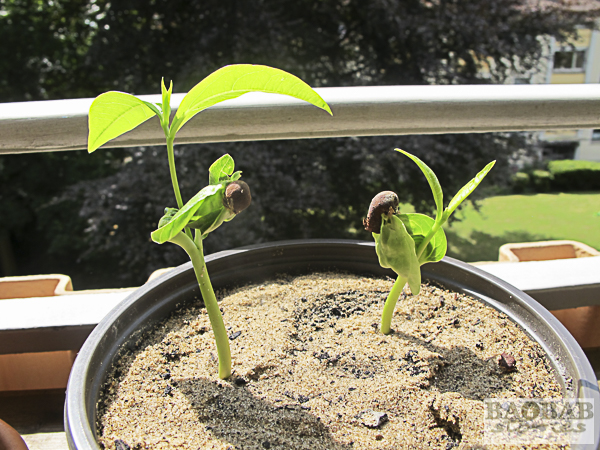
Baobabs on Balkony, a few days old
1. The right location
In the wilderness, baobabs are mainly found in hot, dry savannah areas with little rainfall and meagre soils. They are frugal and usually require little fertiliser. They love the sun, even though the leaves of the small baobabs can get sunburnt in the glaring sunlight. Place your baobab in a bright window where it gets daylight and as much sun as possible – south-facing windows are particularly suitable.

Baobab Seedlings, a few days old
In summer, you can place your potted baobab on the balcony, terrace or in the garden. Here, too, you should place it in the sun. The trees don’t like being moved too often and they don’t like draughts either. If it rains a lot, you should ensure that the water drains away from the pot. Standing water can cause the roots to rot. In autumn and at the latest when the temperatures drop again, take your baobab indoors or place it in a conservatory. Find more on this topic under “temperature”.
2. The right temperature
Very small baobabs thrive best if they are exposed to a constant temperature of about 24°C in the first period after germination. They are very susceptible to cold and do not tolerate frost. They also do not appreciate draughts. Therefore, you should keept your baobab over winter in a warm place. Take the tree indoors once the temperatures drop in autumn – best before they drop below 15° C. Keep it at about 18° C preferably. Baobabs are deciduous trees. Therefore it is normal for them to drop their leaves in autumn – just like beech, birch and oak trees. Heated living rooms are usually a little too warm for their well-being in autumn/winter. However, they also survive such phases well if you take a few things into account (see article on overwintering baobabs).
As they reduce their metabolism once the days get shorter in autumn and start shedding their leaves, they will need less water. Therefore, you need to reduce the amount and frequency of watering your baobabs. However, if the baobabs are placed in a well-heated living room, they may keep their leaves until the end of winter without dropping them at all. In this case, they need more water than baobabs without leaves.
3. The right water supply
Unlike their larger counterparts in the wild, small baobabs need regular but moderate watering. Not too much, but not too little either. Therefore, it is difficult for small baobabs to find ideal growing conditions in the wild. In some regions, for example, successful propagation occurs only every 50 to 100 years – just when all the conditions are right for them.
Water your baobabs properly
In the pot, the freshly sprouted baobabs must not dry out. To avoid overwatering, I usually proceed as follows: I pour such an amount of water that the surface of the pot is completely covered with it and let the water soak in. Leftovers that collect in the saucer I tip away. In the days that follow, I watch the leaves of the small trees closely. With a little practice, you can tell from their appearance whether the plant needs water again or not. You should only water when the soil is dry – but not completely dry. On particularly hot days I water every 2 – 3 days. When it is cooler outside and the water in the pot does not evaporate so quickly, I give it some more time until I water again.
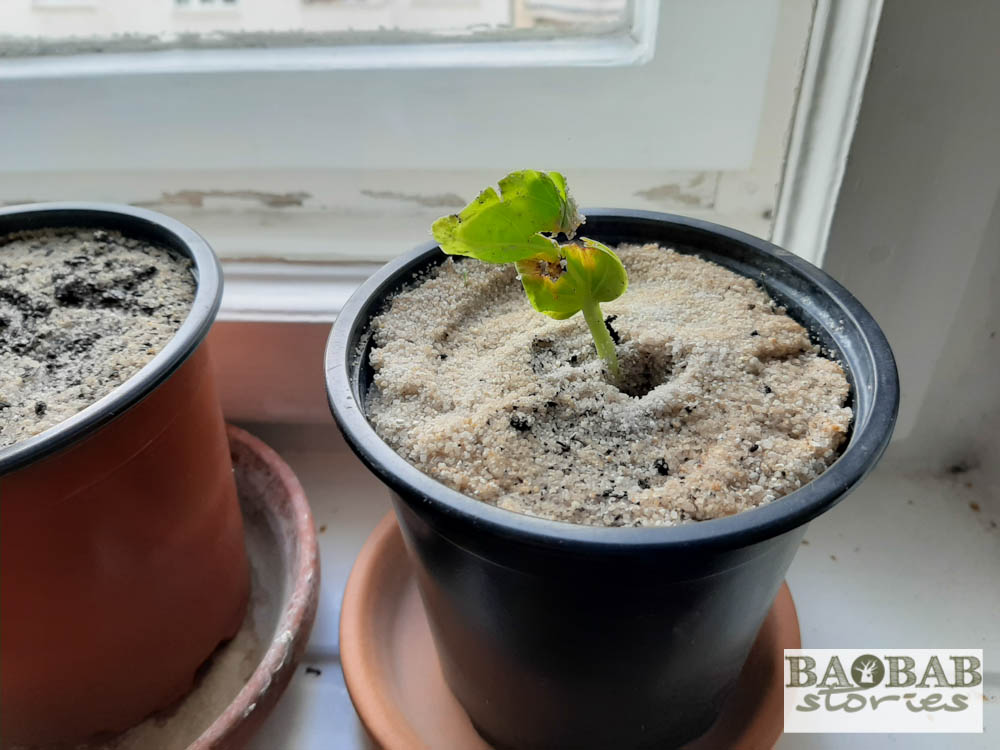
First baobab leaves unfold
To see if the soil in the pot is dry, test it with your finger: poke it into the soil near the plant as deep as possible. If it still feels moist, wait before watering. This will prevent the area around the roots from becoming too moist. Make sure that the water can drain off well from the pot (see “The ideal soil”). If it collects in the saucer, pour it away. Baobabs do not tolerate waterlogging, they easily get root rot and die. If the baobabs are left outside during long and heavy rainfalls, they may get too cold and develop root rot, too. In this case, move them to a warmer and dry place until the conditions change, then take them outdoors again.
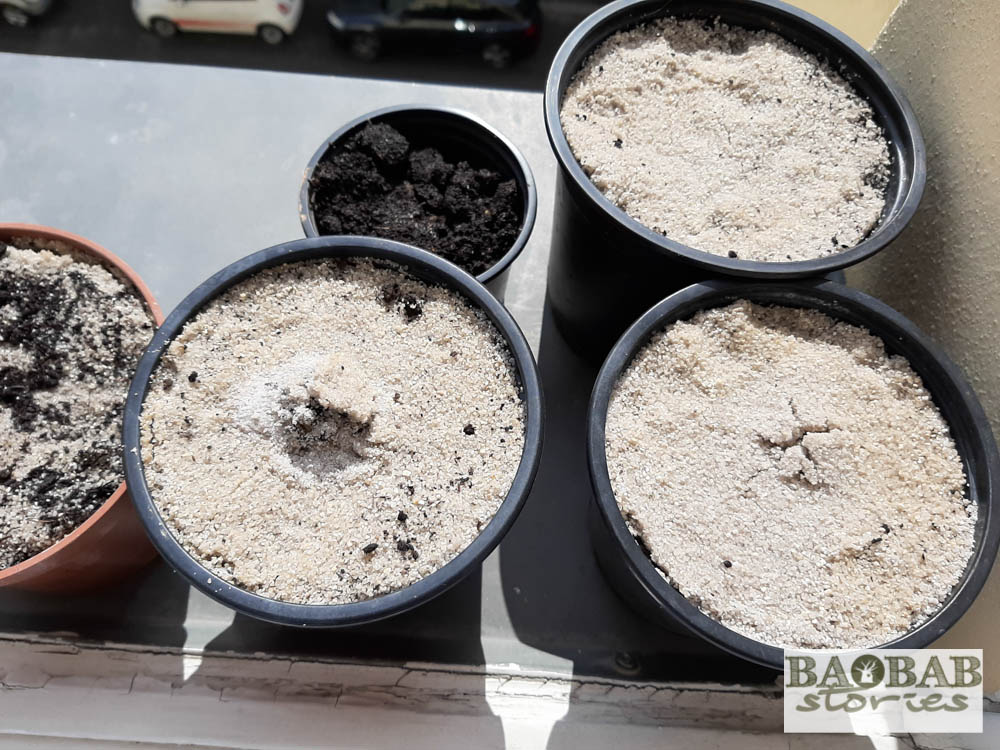
First baobab leaves breaking through soil
4. The ideal soil
Although baobabs can grow in the strangest of places, there are a few criteria you should consider when choosing the right soil: baobabs do best in somewhat sandy soil that allows good water drainage. Nevertheless, they need “mass” in the soil that allows them to root well. This is one oft the reasons why baobabs are not found in the Sahara – they cannot hold on with their roots in loose sand. Very large specimens would simply fall over. The trees do not like clayey soils because they do not allow good water drainage. They can tolerate salinity to a certain extent, but it is not one of their preferred substrates. They find the optimal soils for their needs where they are very common anyway: In the south, east and west of the African continent.

First baobab leaves breaking through soil
In Germany, I prefer to use cactus soil, which I buy in specialist shops. If I don’t have suitable sand available, I simply use this soil as it comes out of the plastic bag. Sometimes I add a mixture of normal garden soil and river sand. The sand should be coarse so that it allows good water drainage. Bird sand from the pet shop is definitely too fine. It tends to clump together and therefore the water drains poorly. Use a flower pot with at least one hole in the bottom. Place pebbles at the bottom and fill in the soil. An option to a mix of soil and river sand may be growth granules – also known as Seramis in Germany – which I do not have any experience with. With coconut fibres I have had rather bad experiences. Therefore I prefer to plant my baobabs in a soil-sand mixture. From this the trees can usually get their nutrients for about two years without additional fertilisation. After two years in the pot, you can either add nutrients with fertiliser when watering or repot the trees in new soil.
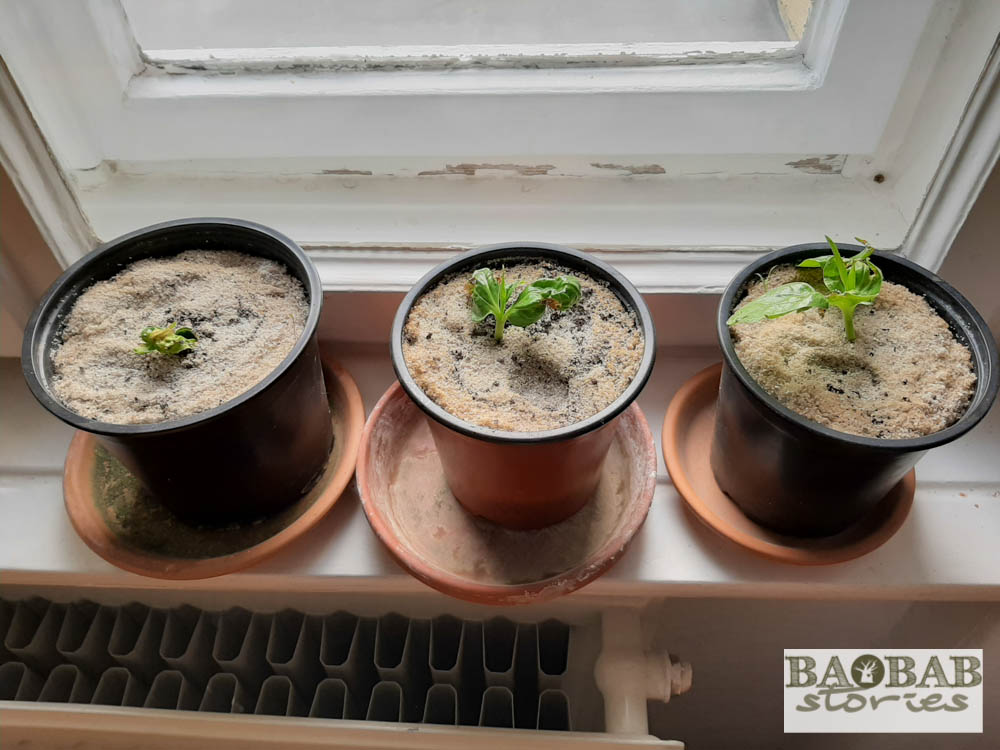
First baobab leaves unfold
5. The best timing for germinating baobab seeds at home
Generally you can grow baobab seeds at any time of the year. They need about 10 – 12 hours of light per day, in winter for example from artificial light sources. In addition they need temperatures around 24° C. However, the phase after germination can be problematic for seedlings that have germinated in European autumn/winter. If they shed their leaves after only a short time of growth, they will have a harder time surviving the leafless phase during winter until they are ready to grow new leaves. While the tiny baobabs have no leaves, watering becomes more complicated.
The photographs below this paragraph show three little baobabs that germnated in August last year. Two of them only had developed six leaves during their growth period when they dropped their leaves in November. Due to draught and too much water one of the taller baoabs died. The third one never made it to more than two leaves. It seems stuck at 2 centimeters since November. Some of the first leaves nicely show that they have been hurt while cutting the outer seed coat or while I took off the seed coat after watering them (see brown spots).
- Little baobab without leaves
- Little baobab at 2 cm height
- Dead little baobab
- Slightly deformed little leaves, probably hurt while scratching seed coat or peeling after soaking
- Slightly deformed baobab leaves – probably hurt while scratching seed coat or peeling after soaking
- First baobab leaves unfold
For taller baobabs it is easier to survive a dormant phase without leaves as they can store water in their trunk, roots and branches. I have had the best experience with growing baobab seeds in late spring, i.e. end of May/early June. That gives the little baobabs time to grow with a long and warm summer ahead of them. In the first three months after germination, they develop their small taproot, in which they store important nutrients. At the same time, they sprout leaves and gain in height.

Baobab tap root, a few months old, Heike Pander
Long days are an asset fort he little baobabs. In recent years it has also been warm enough – usually over 20° C during the day. The little baobabs like that. If you plant the seeds too late in the year – i.e. not until August – they don’t have enough time to develop enough roots and leaves before the days get shorter and the temperatures drop. They usually drop their leaves earlier than larger baobabs – they have not yet formed as many reserves in their roots, trunk and branches. In this case they run the risk of getting root rot and not surviving the winter months. Baobabs that have sprouted earlier in the year have had more time to grow and therefore survive the winter and their dormant period more easily. The photograph below shows one of the baobabs from August last year. At the tip it shows tiny reddish fibres – a good sign that it will start growing from there in spring. If it survives the rest of these winter months.

Little baobab with tiny “hair” where new leaves will sprout in spring
In the northern hemisphere, baobabs behave like our native trees when it comes to sprouting leaves in spring. This also applies to the shedding of the leaves in autumn. Baobabs are usually native to the southern hemisphere. There, the seeds germinate with the onset of the rainy season, when they have the greatest chance of regular water supply. In South Africa, the rains normally start in summer, i.e. from November, when we in the northern hemisphere are already rapidly heading towards winter – in other words, exactly anticyclical to the behaviour of baobab seeds in Europe.



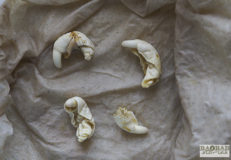
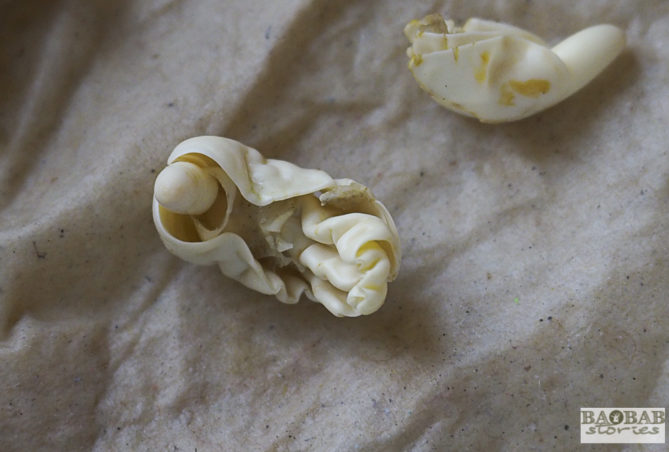




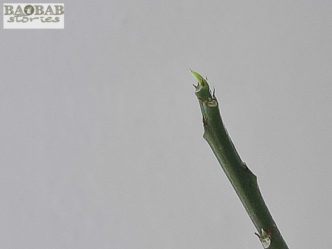


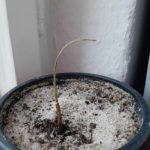

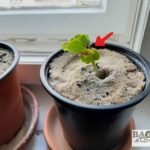

Thank you. This post is very helpful. I just germinated Baobab seeds using your instructional video. I am in Western Pennsylvania in the USA. My germination rate was 100% with one little tree seeming to be very strong. I germinated them on top of my fridge under a grow light. They are about a month old now. I am glad I read your article because i was about to repot them but will wait another two months before I do so. Because of our climate they will spend the majority of their lives in the house or greenhouse to ensure they do not get too cold. With that being said they can be outside under shelter here from about mid June to the end of August. Thank you!!!! I love your site.
Dear Abby, thank you very much for your positive feedback & congratulations for growing your own baobabs from seeds! I am glad that you were successful by following instructions in my video and that you found the information on repotting at the right time. Enjoy your little trees, good luck & all the best – Heike
Dear Heike,
I started growing baobabs one month ago and my plant is now 5cm high. I live in The Netherlands so I worry about the temperature and kept my baobab in a small indoor greenhouse. Which gave me another worry, that my baobab gets too little sunlight since the greenhouse has unusual blue plastic instead of glass.
I took it out as soon as I noticed its leaves turned mushy and started hanging. Eventually the only 2 leaves it had fell off.
I water it warm water (20C or something alike). And it currently has a lot of sunlight.
What is your advice? I watched your video on how to germinate it and it worked well! So I thought I should ask you.
Thanks a lot!
Kind regards,
Daphne
Hi Daphne, thank you for getting in touch. First of all congratulations that your seeds germinated, that is wonderful. The other information does not sound very promising and I am afraid that the little tree did not get enough light and that you kept it too moist. The climate in the greenhouse was probably not ideal. I have tried my luck with little green houses, too – all the seeds/little trees did not make it. Maybe you have have overwatered it. Once the leaves start to show signs like you describe on your little tree it may be too late. They do not have much root and if that is affected by root rot they are gone quickly… Sorry for that. In order to check whether it needs more water, poke your finger into the soil near the roots. If that still feels moist or wet wait until it feels dry. Then it is ok to pour more water. Basically all you can do at the moment is wait, keep it at a warm spot, if possible with sunlight and no excessive watering. Good luck & all the best to you and your little tree, Heike
Hello Heike,
I have successfully grown Australian baobabs that were planted using your method on the 15th of March. They are growing in a 9x9x10 cm pot and I notice the root starting to poke out of one of the holes in the bottom. Will it hurt to keep them in those pots until the next growing season? They are still quite young, about 13 cm tall.
Hi Emile, congratulations to growing boabs! It does not get clear to me whether you have more than one boab growing in a pot. If so, it would be helpful if you can repot so that they have enough space for their roots. They are above the critical time of 3 months – so repotting should be all right. As far as I know it should not hurt them if you keep them in the pot where they are now and repot next year. It may reduce their speed of growth though… All the best to you and your boabs!!! Kind regards, Heike
it is a very well-written article on baobab seeds germinating, thank you for the valuable and useful information you provide
Thank you!
The instructions say to water it thoroughly and then let it dry. Within a few days it sprouted leaves but now they have all fallen off and the plant seems to be doing nothing. It is kept warm and has a bright south window, so it gets lots of sunlight.
Hi there & sorry for the late response. Where did you get the instruction from to water and let dry? And let what dry – the seed or a plant? In order to give you more detailed information I need more preceise information from you. Do you live in the northern or southern hemisphere? Did you try to grow baobabs from seeds or are you talking about a seedling? Thanks for getting back to me & kind regards, Heike
Hello –
I have a 10’ tall baobab tree I moved indoors for the winter. In December spider mites and aphids became apparent. I sprayed with a alcohol water solution and used a systemic. The insects are still present. Three weeks later I sprayed with a soapy water solution. The baobab lost 30% of its leaves over the past two months and I worry it’s uptake is too slow this time of year for the systemic to practically work. And dragging a 10’ tall tree outside in freezing temps to spray is not working.
If it is at a mature size to handle leaf drop for dormancy – can it handle leaf drop from mite damage and leaf back out in the spring? Should I try to trigger leaf drop with falling temperatures instead of warm temperatures with sustained insect damage?
Hi Amanda – thank you for getting in touch and sorry to hear that your baobab has caught spider mites and aphids. What I usually do is take the pots with affected baobabs into the shower and let water pour over the leaves. You may have to repeat that for several times and you have to make sure that none of the aphids and spider mites get into the soil. So far this treatment has helped my baobabs. Baobabs are deciduous trees and it is quite normal for them to drop their leaves in fall. As they carry pests you should make sure to remove the fallen leaves. If the tree has meanwhile lost all its leaves: clean the branches and stem with water. Do not leave too much water in the pot as it may cause root rot without the leaves. Usually baobabs get new leaves in spring. Hope this helps you. Good luck and all the best to you and your baobab. Kind regards, Heike
Hi Heike,
I just discovered your website, and I am so glad I did! Thank you for all the information, it helps so much! I recently received a bonsai starter kit and some baobab seeds with it. As you may know bonsai pots are very small (mine is 5cm deep and 10x10cm) and I only saw from your articles now that baobabs need medium sized pots. My little baobab is only a few weeks old and growing well (although it has been a little cooler now in Germany). I saw the root is growing out the bottom drainage hole and was wondering if I should take the chance to repot it? Or would you suggest waiting for the 3 months to pass? I only have one seedling in the pot.
Thanks alot!
Regards,
Jessica
Hi Jessica, thanks for getting in touch & congratulations to your baobab project. I know that the bonsai pots tend to be very small – nevertheless, baobab roots are quite flexible. Normally, their roots tend to grow straight into the soil for approximately 10 cm. Then they form their taproot. If you planted your baobab in the little pot, it will try to grow straight into the soil and therefore grows through the drainage hole. If you are careful while you repot it that should be ok. You could try to fit the root poking out at the bottom back into the pot by carefully bending it a little. I would not recommend cutting it at this stage. Your other option is to leave it in the pot where it resides at the moment & wait for the three months and then repot it. In my experience it does not hurt the plant if the root shows at the bottom of the pot. Make sure you do not overwater though – otherwise the remaining water in the bottom tray may cause root rot to the little tree. Hope that helps & all the best to your baobab project, Heike
My seeds all germinated well. They are growing fast, but are very delicate and have tendrils, which seems odd to me. I have separated them and have placed stakes. Should I top them for the trunks to get stronger? They are two weeks old and already 16 cm tall.
Dear Kimberley, thank you for getting in touch. I am not sure if what you describe refers to a real baobab. I have never heard of tendrils on a baobab (and neither have I seen any myself…) and usually the stems do not need support as they grow strong from the beginning. Further, I would not recommend to top them at this early stage as they need the leaves to produce their food. They cannot rely on their rootsystem yet. Hope this helps & kind regards, Heike
Dear Kimberley, thank you for getting in touch. I have neither heard of nor seen myself tendrils on a baobab – that (in deed) sounds odd. And they usually do not need stakes to support the stems as the latter grow strong from the beginning. What you grow does not sound like a baobab to me. Further I do not recommend to top them as they need their leaves in the early stages to produce their food. They cannot rely on a taproot yet… Hope that helps. Kind regards, Heike